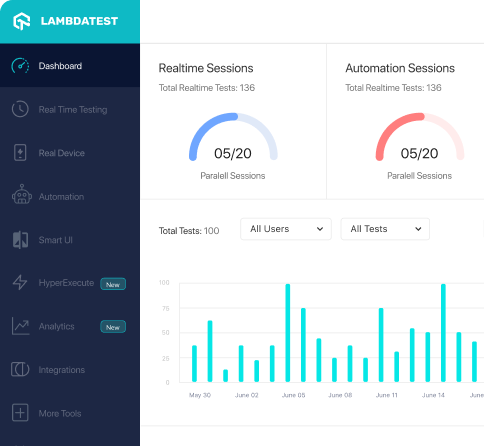How to use AfterScenarioTest class of com.tngtech.jgiven.junit package
Best JGiven code snippet using com.tngtech.jgiven.junit.AfterScenarioTest
Source: AfterScenarioTest.java
...9import com.tngtech.jgiven.junit.test.BeforeAfterTestStage;10import com.tngtech.jgiven.junit.test.ThenTestStep;11import com.tngtech.jgiven.junit.test.WhenTestStep;12@RunWith( DataProviderRunner.class )13public class AfterScenarioTest extends ScenarioTest<BeforeAfterTestStage, WhenTestStep, ThenTestStep> {14 @BeforeClass15 public static void beforeClass() {16 BeforeAfterTestStage.afterScenarioCalled = 0;17 }18 @DataProvider19 public static Object[][] testData() {20 return new Object[][] { { 0 }, { 1 }, { 2 } };21 }22 @Test23 @UseDataProvider( "testData" )24 public void testAfterScenario( int expectedCallCount ) {25 Assertions.assertThat( BeforeAfterTestStage.afterScenarioCalled ).isEqualTo( expectedCallCount );26 when().something();27 }...AfterScenarioTest
Using AI Code Generation
1public void afterScenario(){2}3public void afterStage(){4}5public void afterTest(){6}7public void beforeScenario(){8}9public void beforeStage(){10}11public void beforeTest(){12}13public void jGivenRule(){14}15public void jGivenTestRule(){16}17public void jGivenTestRule(){18}19public void jGivenTestRule(){20}21public void jGivenTestRule(){22}23public void jGivenTestRule(){24}AfterScenarioTest
Using AI Code Generation
1public void afterScenarioTest() {2 System.out.println("After Scenario Test");3}4public void afterScenarioTest() {5 System.out.println("After Scenario Test");6}AfterScenarioTest
Using AI Code Generation
1package com.tngtech.jgiven.examples;2import com.tngtech.jgiven.junit.AfterScenarioTest;3public class AfterScenarioTestExampleTest extends AfterScenarioTest<AfterScenarioTestExampleTest> {4 public void some_test_that_fails() {5 given().some_state();6 when().something_happens();7 then().something_should_have_happened();8 }9 public void some_test_that_passes() {10 given().some_state();11 when().something_happens();12 then().something_should_have_happened();13 }14}15package com.tngtech.jgiven.examples;16import com.tngtech.jgiven.junit.AfterScenarioTest;17public class AfterScenarioTestExampleTest extends AfterScenarioTest<AfterScenarioTestExampleTest> {18 public void some_test_that_fails() {19 given().some_state();20 when().something_happens();21 then().something_should_have_happened();22 }23 public void some_test_that_passes() {24 given().some_state();25 when().something_happens();26 then().something_should_have_happened();27 }28}29package com.tngtech.jgiven.examples;30import com.tngtech.jgiven.junit.AfterScenarioTest;31public class AfterScenarioTestExampleTest extends AfterScenarioTest<AfterScenarioTestExampleTest> {32 public void some_test_that_fails() {33 given().some_state();34 when().something_happens();35 then().something_should_have_happened();36 }37 public void some_test_that_passes() {38 given().some_state();39 when().something_happens();40 then().something_should_have_happened();41 }42}43public void afterScenario() {44}45public void afterTest() {46}47public void afterFailedScenario() {48}Blogs
Check out the latest blogs from LambdaTest on this topic:
When I started writing tests with Cypress, I was always going to use the user interface to interact and change the application’s state when running tests.
Entering the world of testers, one question started to formulate in my mind: “what is the reason that bugs happen?”.
In today’s data-driven world, the ability to access and analyze large amounts of data can give researchers, businesses & organizations a competitive edge. One of the most important & free sources of this data is the Internet, which can be accessed and mined through web scraping.
Web applications continue to evolve at an unbelievable pace, and the architecture surrounding web apps get more complicated all of the time. With the growth in complexity of the web application and the development process, web application testing also needs to keep pace with the ever-changing demands.
JavaScript is one of the most widely used programming languages. This popularity invites a lot of JavaScript development and testing frameworks to ease the process of working with it. As a result, numerous JavaScript testing frameworks can be used to perform unit testing.
Automation Testing Tutorials
Learn to execute automation testing from scratch with LambdaTest Learning Hub. Right from setting up the prerequisites to run your first automation test, to following best practices and diving deeper into advanced test scenarios. LambdaTest Learning Hubs compile a list of step-by-step guides to help you be proficient with different test automation frameworks i.e. Selenium, Cypress, TestNG etc.
LambdaTest Learning Hubs:
- JUnit Tutorial
- TestNG Tutorial
- Webdriver Tutorial
- WebDriverIO Tutorial
- Protractor Tutorial
- Selenium 4 Tutorial
- Jenkins Tutorial
- NUnit Tutorial
- Jest Tutorial
- Playwright Tutorial
- Cypress Tutorial
- PyTest Tutorial
YouTube
You could also refer to video tutorials over LambdaTest YouTube channel to get step by step demonstration from industry experts.
Most used methods in AfterScenarioTest
Try LambdaTest Now !!
Get 100 minutes of automation test minutes FREE!!



